|
|
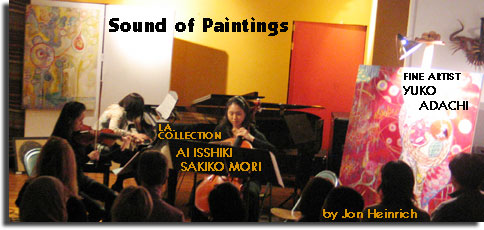 |
In a night of creative interpretation, fine artist Yuko Adachi
and musicians Ai Isshiki and Sakiko Mori juxtaposed original
and existing music against oil paint. At the cozy Zeitgeist
Gallery in Cambridge, Mass., the artists used each other’s
works as cross-inspiration in an aurally colorful blitz of the
senses.
Echo
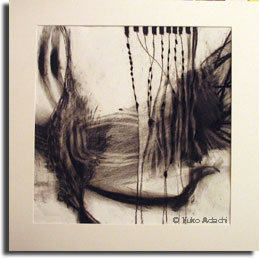 When
the group decided to collaborate, Ai Isshiki, the composer of
Echo gave Adachi the assignment of creating a piece of artwork
by listening to her original composition. The result was a smaller
charcoal drawing placed in the spotlight before the two featured
composers seated at the grand piano. When
the group decided to collaborate, Ai Isshiki, the composer of
Echo gave Adachi the assignment of creating a piece of artwork
by listening to her original composition. The result was a smaller
charcoal drawing placed in the spotlight before the two featured
composers seated at the grand piano.
The instruction was to paint the piece in two minutes and to
work in black and white—two rules that patient colorist
Yuko Adachi is not used to. In order to literally draw the sounds,
Adachi would come up with adjectives while she listened to the
music, like creepy, eerie, mysterious, beautiful, serene and
peaceful. What she found was that she couldn’t resist
adding a little colored paint to the mix. That’s when
she grabbed the charcoal.
Says Adachi: “I listened to their music and tried to
express the mysteriousness from the energy of an echo, from
one side to another.”
While this assignment was a challenge, Adachi understands that
spiritual growth requires an open path. The challenge is opening
the boundaries of knowledge and the only way to do this is by
not planning. “It’s really scary in a way,”
admits Adachi, “but exciting because you don’t know
what’s going to come out. It’s all about exploring
your unlimitations.” By applying process and
hard work, she discovered a new way of creation. “You
open the boundaries, and go for it.”
|
Metaphysical
Crush
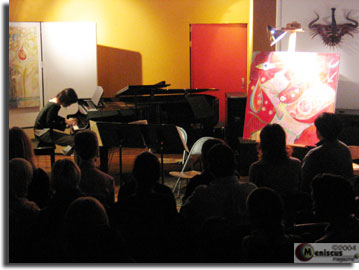 The
next feature of the evening was a large canvas called Metaphysical
Crush. Mori chose the Stravinsky piece, Tango to verbalize
the essence of this colorful representation of Adachi’s
spirit. The
next feature of the evening was a large canvas called Metaphysical
Crush. Mori chose the Stravinsky piece, Tango to verbalize
the essence of this colorful representation of Adachi’s
spirit.
People talk about meeting a spiritual friend,
a soul mate you knew in a former life. Before she was inspired
to paint this piece, Yuko never had that experience. “I
heard about it,“ Adachi explains to the captive gallery,
“but it just sounded like one of those stories.”
That was until she met this person. “I
looked into his eyes,” pausing with great emphasis, “his
eyes and my eyes just beamed to each other! I didn’t know
this person but as we started to talk, we looked into each other
and his eyes were like a galaxy! We felt the beam of each other’s
souls and we couldn’t look away from each other. It was
something that I’ve never had before.” He felt the
same.
Something made that moment so emotional, and
although she didn’t know this person, she felt a strong
affinity. But when two people connect, its good to be close.
When they touched, the intrigue only intensified.
|
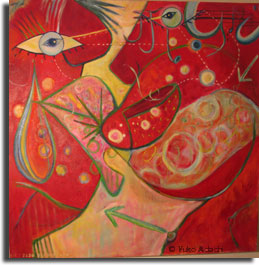
Adachi calls this a Metaphysical Crush because
her experience was not just typical sexual attraction. This
meeting was actually a wake-up call from a spiritual world.
Experience conveys spirituality so strongly—more than
a book ever could.
He was a catalyst that helped Adachi realize
that her soul wasn’t born when this physical body of hers
was born. “I must have been somewhere [in a past life]
where I knew this guy. It was a very important spiritual experience
for me so I had to paint this.”
That’s when Adachi learned what it means
to be a soul mate: “I realized there are many. A soul
mate doesn’t necessarily equal ‘the one’,
or the one you’ll be married to. It can be someone you
connected with in one way or another. Its so intimate you don’t
have to be with that person for the rest of your life, that
moment is enough.”
|
Unlocking the layers
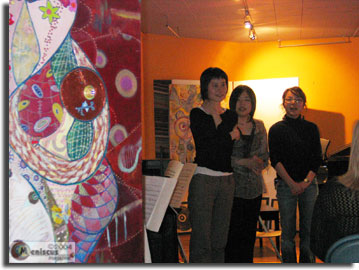 The next presentation was a piece composed by Ai Isshiki to
match Adachi’s painting, Unlocking the Layers. Played
as a trio, Isshiki was joined by Jaehee Ju on cello and Ying
Xue on violin.
The next presentation was a piece composed by Ai Isshiki to
match Adachi’s painting, Unlocking the Layers. Played
as a trio, Isshiki was joined by Jaehee Ju on cello and Ying
Xue on violin.
Gesturing towards the painting, Adachi explains that every
relationship you have with someone transforms your life. When
you live in this world, people expect you to behave in certain
ways, since you are twenty something, upper class, lower class
or whatever your situation may be. People put a certain stereotype
onto you that sometimes you can’t live up to. Society
tries to force you to do as you’re expected. “But
I think its really unnatural trying to conform to something
someone else has on you,” explains Adachi. As a result
we put up invisible barriers to separate our true self from
the real world. After years of this, it’s easy to forget
who that true person is behind the mask.
|
“If you take all these layers,” continues
Adachi “it's like a fake mask we’ve put on. But
below all of those layers, it all boils down to this little
soul of love. I think everything in the end, is all about love!”
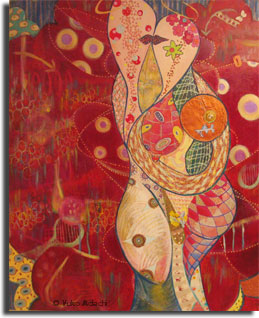
Pointing to the copper colored circle in the
middle of the painting, she explains that this is her breast,
her heart, made out of metal, representing the barriers. But
also there’s a key with wings ready to open it up. Surrounding
the couple is a beautiful field of energy.
It’s about opening yourself up.
Notice the spiral of energy going through the
two; the arc of energy; the intertwining female and male organs;
the whole arm that wraps around one body that becomes two bodies
that becomes one. Looking at the two people kissing, the intertwining
colors and Adachi’s explanation gave me goosebumps. If
you just saw the energy of two loving beings, this is what you’d
see.
Among many messages, the painting has one main
idea: Lose the mask and just be yourself! “It really is
about sharing the energy,” explains Adachi. “This
just shows two people, but I always believe energy extends.
It’s not a boundary, it is floating everywhere. Whether
it’s positive or negative…it stimulates you, wakes
you up.”
|
Gift of Growth
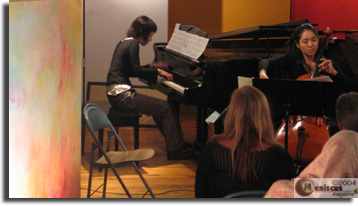
Moving on to the next presentation of the chilly
New England evening, Adachi hoisted a colorful wooden panel
entitled Gift of Growth into the limelight. Led by pianist Sakiko
Mori, the quartet accompanying this painting comprised of Shan
Shan MA on clarinet, Yin Xue on violin and cellist Jaehee Ju.
To express musically what Yuko has laid out in colors, the quartet
choose the fourth and fifth movements of Mussiaen’s Quartet
for the End of Time.
|
| “I really
think the painting is a documentary of me as a person, to be shared
with other people,” says Adachi. “It’s a visual
diary.” When Yuko was 26 and graduating from school and
going through many emotional struggles, she realized that when
you’re so lost, you seek certainty.
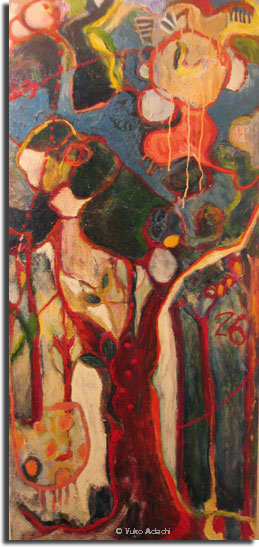 But
you can always find assurance and stability if you know where
to look. But
you can always find assurance and stability if you know where
to look.
“When I look at nature,”
explains Yuko, “I notice how courageous it is. Every year
it grows out of the ground from the harsh weather, repeating this
beautiful cycle of life. There I found such encouragement. Even
though I was so lost in life, nature taught me to get back on
this beautiful cycle. It showed me to never give up.”
It’s easy to take the greenery
of spring as inspiration if you pause to pay attention. Despite
the inhospitable conditions of winter, the roots are always alive
and waiting for the next season of growth. And every year, the
trees grow bigger and bigger. “It just gives me so much
power to know that nature can give us the beauty of life,”
says Yuko. This cycle; this rhythm; it makes sense. Yuko’s
colors across the organic wooden panel express the only reason
she’s here: to grow each and every year. Standing in front
of the two-dozen souls in the audience, Yuko turns the floor over
to the quartet with one final reflection: “Everyone is given
this gift of growth,” she says. “It’s called
hope.”
|
George and
Rosemary (tentative title)
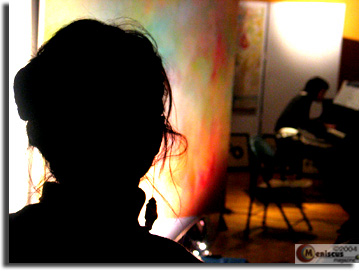 The
final piece of the evening was an oil painting Adachi created
to the music of George and Rosemary, an animated project Isshiki
composed for a short animation film as a final project for her
film scoring degree at Berklee. Yuko painted the original piece
from listening to the music alone. The
final piece of the evening was an oil painting Adachi created
to the music of George and Rosemary, an animated project Isshiki
composed for a short animation film as a final project for her
film scoring degree at Berklee. Yuko painted the original piece
from listening to the music alone.
The sound was in line with what
contemporary composers are doing these days in contrast to true
classical composers like Mozart and Bethoveen: using an abstract
rhythm and employing silence to create impact. It caused the
listener to go deep into a space where your body is here, but
your mind goes somewhere else. This piece was performed by just
a piano at the gallery but the music is scored for a full symphony—as
Yuko listened to it to create her new masterpiece.
|
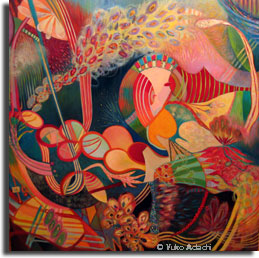 It
was fairly easy for Adachi to relate to the music. “The
musicians reach for the same level that I reach for in my
painting,” says Yuko, “very courageous and unconventional.” It
was fairly easy for Adachi to relate to the music. “The
musicians reach for the same level that I reach for in my
painting,” says Yuko, “very courageous and unconventional.”
What became of the exercise is
a pure reaction to the music: “It was absolutely fun,
beautiful, adventurous and innocent; it has all kinds of drama
to it.” The melodies contain a magical glimmer of fairy
tale fantasy, fraught with hope.
“It put me into this imaginary
world of excitement,” recalls Yuko. “Everything
I heard, I tried to make it into a painting. When I listened
to the music, I would mimic the sounds with the stroke of my
brush.”
At the end of the show, the crowd
was chastised for being late by the group coming into the Zeitgeist
for the late night affair. People had so much to talk about,
it was difficult to get them to leave. We, like the artists,
learned some amazing insights that night. Through the process,
Adachi discovered that music speaks a different language than
the paint brush. But once the creative energy connects, she
was able to create layer after layer like an architect building
a representation of Ai Isshiki and Sakiko Mori’s contemporary
classical music. “That’s the amazing thing about
oil paint,” Yuko Adachi recalls hinting at the hidden
metaphor, “it opens you up to an unpredictable mix of
layers.”
Jon
Heinrich
For more information about
Yuko, check out:
www.yukoadachi.com/
|
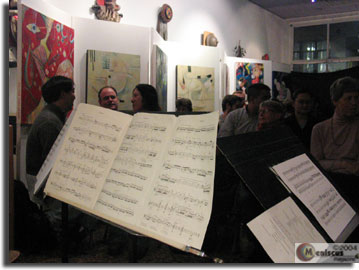 |
|
|

